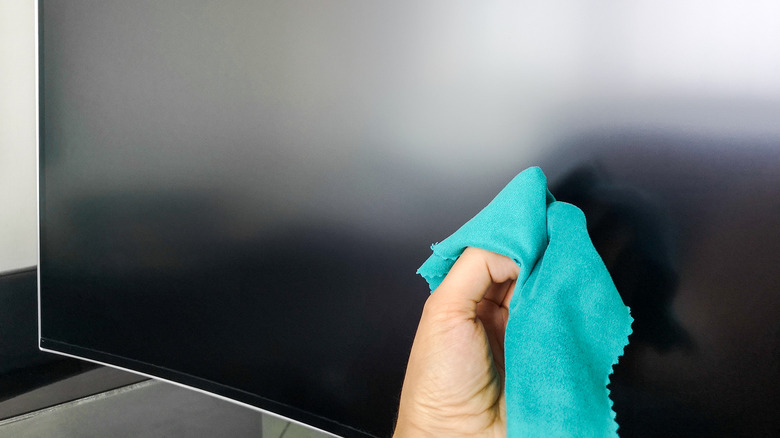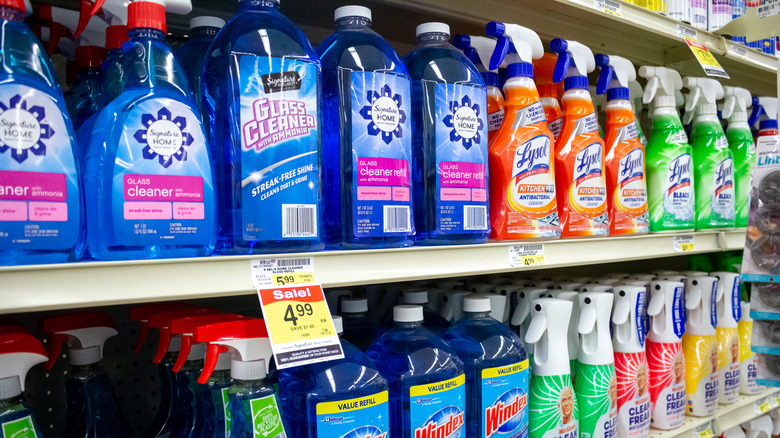Here's How To Clean Your TV Screen The Right Way
We may receive a commission on purchases made from links.
Wondering how to clean your TV screen without scratching it? Start by getting the right tools for the job. Skip the screen cleaners and use a dry microfiber cloth instead. Traditional glass cleaners, such as Windex, contain alcohol, ammonia, and harsh chemicals that can damage the TV screen, according to CNET. As a rule of thumb, check the manufacturer's instructions and then decide which products to use.
Dust, fingerprints, and smudges can affect your viewing experience. Even if they're not obvious, they can still have a negative impact on the performance and lifespan of your TV. The problem is that modern TV screens, such as LCD and OLED, are sensitive and can be easily damaged by chemical cleaners. Depending on the brand and type of screen, you may not be able to use soap or household cleaning products.
One option is to buy a screen cleaner kit, but it may not be worth it. Most times, a soft cloth will do the trick. Consider using one designed for cleaning glasses and sunglasses, per CNET. Next, follow the instructions below to clean your TV screen safely.
How to clean your TV screen without damaging it
Most Americans spend about four hours watching TV each day, according to California State University, Northridge. The same source reports that 66% of U.S. households have three or more TV sets. Regardless of the time spent watching TV, dust can accumulate on its screen, air vents, and speakers. If you have children, you may also be dealing with fingerprint smudges and food stains.
Modern TVs have sophisticated screens that require special care. They are a lot more sensitive than old-school TVs, which had glass screens. For starters, it's not necessary to turn off and unplug your flat-screen TV before cleaning it. However, doing so will eliminate the risk of static shock and make it easier to spot stains. Next, check the user manual or visit the manufacturer's website to download it.
Sony, for example, recommends unplugging the power cord prior to cleaning your OLED or LCD TV screen, and then wiping the display with a soft, dry cloth. Dilute a non-soap cleanser with water, soak the cloth in it, and then gently clean the screen to remove stubborn stains, such as ink. Samsung, on the other hand, suggests using a dry microfiber cloth to get rid of dust. If there are any stains or fingerprints left, spray distilled water onto the cloth and then gently wipe the TV screen.
Avoid these products when cleaning your TV
Windex was a pretty good choice for cleaning old TVs, but you should never use it on LCD and OLED screens. Sony also advises against the use of chemicals containing benzene and other harsh chemicals. Acetone, alcohol, and ammonia are off-limits, too (via Samsung). These products can remove the anti-reflective coating and affect your viewing experience.
Pre-treated dusting cloths are not better either, says Good Housekeeping. While they're effective at removing dust, they contain oils that can build up on the TV screen and leave marks. Screen cleaners are generally safe, but you can get the same results with a microfiber cloth.
If you're dealing with ink or grease stains, it's okay to use a damp cloth. Just make sure you don't spray anything on the screen. Apply a little bit of water on the cloth and then gently wipe the display in a circular motion. When you're done, use a dry microfiber cloth to clean your TV screen once more.


